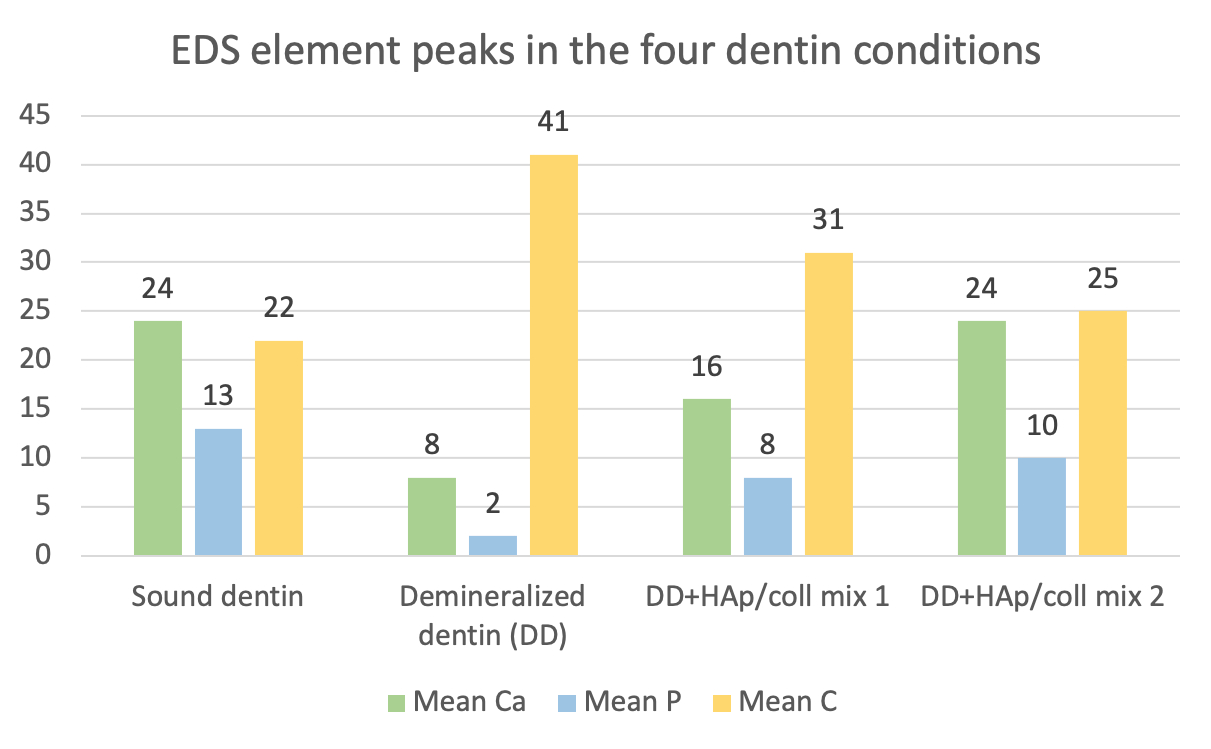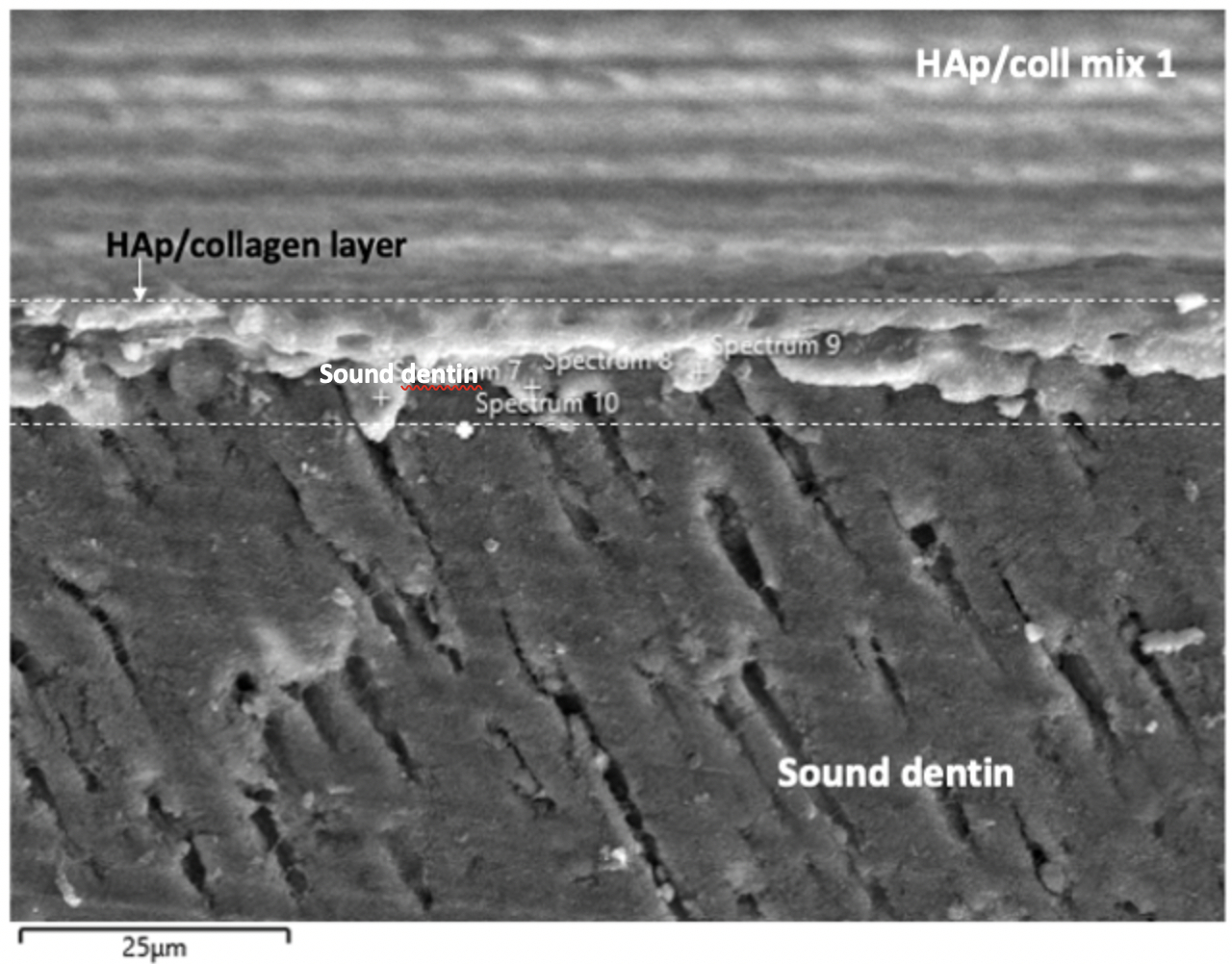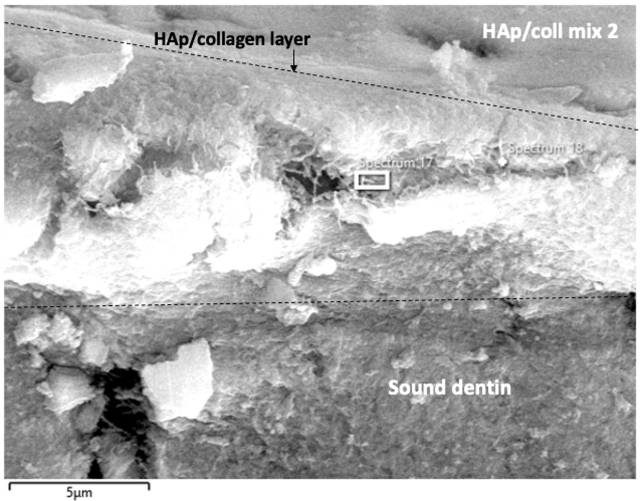IADR Abstract Archives
Biomodification of Demineralized Dentin With Apatite-Collagen Mixture: Chemical and Micromorphological Analysis
Objectives: In the context of minimally invasive dentistry, novel strategies to preserve demineralized dentin may rely in the deposition of a newly formed mineralized tissue. A biomimetic apatite-collagen mixture in terms of microstructure may serve as a scaffold to promote dentin repair. With this in mind, the purpose of this study was to determine if an apatite-collagen compound was able to restitute Ca and P ions to demineralized deep dentin from class I cavities and report on the chemical and micro morphologic characteristics.
Methods: Deep class I cavities were prepared in extracted molars that were anonymously collected. Intratubular fluid flow with a solution of PBS and horse serum was performed in order to simulate the biological situation of a vital tooth. After cavity preparation four dentin types were considered:
1. sound dentin,
2. demineralized dentin after etching with 37% H3PO4 for 20 seconds,
3. demineralized dentin + mixture 1 hydroxyapatite/collagen (HAp/coll mix 1) and
4. demineralized dentin + mixture 2 hydroxyapatite/collagen (HAp/coll mix 2).
After the four procedures cavities were filled with a glass ionomer cement (mixtures 1 and 2 were isolated form the cement by interposing a thin layer of light cured bonding agent (Optibond FL) and stored for 15 days at 37 degrees under dentinal perfusion. The tooth samples were then sectioned, polished and SEM micromorphological assessment and EDS chemical profiles at the interface dentin/mixture were extracted.
Results: Calcium (Ca), Phosphorous (P) and Carbon (C) peaks varied according to dentin types. C peaks were associated with the amount of exposed collagen as peaks up to 41 were observed in demineralized dentin (DD) when peaks of Ca (8) and P (2) were the lowest (Table 1). HAp/coll mixture 1 and mixture 2 presented the closest peaks to sound dentin, indicating that biomodification occurred on demineralized dentin surface. SEM micrographs confirmed these assumptions, in view of the morphology of a layer that was well integrated on dentin surface (Figures 1 and 2).
Conclusions: Recovery of demineralized dentin was possible by the integration of a newly-formed HAp/collagen layer with similar characteristics as the one observed on sound dentin. Further investigations are necessary to evaluate the mechanical properties of this layer.
Methods: Deep class I cavities were prepared in extracted molars that were anonymously collected. Intratubular fluid flow with a solution of PBS and horse serum was performed in order to simulate the biological situation of a vital tooth. After cavity preparation four dentin types were considered:
1. sound dentin,
2. demineralized dentin after etching with 37% H3PO4 for 20 seconds,
3. demineralized dentin + mixture 1 hydroxyapatite/collagen (HAp/coll mix 1) and
4. demineralized dentin + mixture 2 hydroxyapatite/collagen (HAp/coll mix 2).
After the four procedures cavities were filled with a glass ionomer cement (mixtures 1 and 2 were isolated form the cement by interposing a thin layer of light cured bonding agent (Optibond FL) and stored for 15 days at 37 degrees under dentinal perfusion. The tooth samples were then sectioned, polished and SEM micromorphological assessment and EDS chemical profiles at the interface dentin/mixture were extracted.
Results: Calcium (Ca), Phosphorous (P) and Carbon (C) peaks varied according to dentin types. C peaks were associated with the amount of exposed collagen as peaks up to 41 were observed in demineralized dentin (DD) when peaks of Ca (8) and P (2) were the lowest (Table 1). HAp/coll mixture 1 and mixture 2 presented the closest peaks to sound dentin, indicating that biomodification occurred on demineralized dentin surface. SEM micrographs confirmed these assumptions, in view of the morphology of a layer that was well integrated on dentin surface (Figures 1 and 2).
Conclusions: Recovery of demineralized dentin was possible by the integration of a newly-formed HAp/collagen layer with similar characteristics as the one observed on sound dentin. Further investigations are necessary to evaluate the mechanical properties of this layer.



